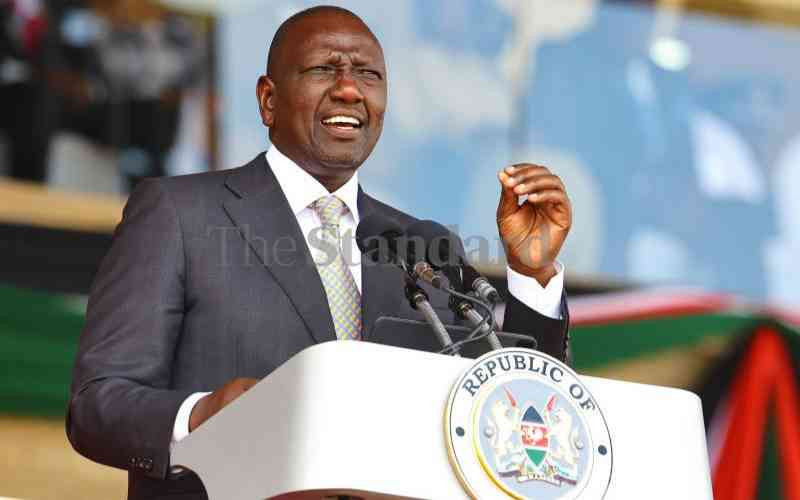On August 27 Kenyans will be celebrating not just the promulgation of the new Constitution six years ago, but also the tangible gains made throughout the country.
The 2010 Constitution heralded a new era of open and inclusive governance best epitomised by devolution, which is helping to bridge the development gap between rich and poor regions. This gap was first created by colonialists who zoned the country into high-potential and low-potential agricultural areas.
The Constitution created 47 county governments where resources and power have been devolved since 2013. Despite teething problems, allocations to counties have risen from $210 million in 2013 to $280 million this financial year, signaling increasing commitments by both levels of government to enhance public service delivery and ultimately making devolution a success for Kenya.
In the difficult process of entrenching devolution, Kenya has enjoyed technical and financial support from the international community and the United Nations.
There are inspiring success stories coming from the counties, like the subsidised seeds and tractor services bringing down production costs for farmers in the North Rift, and rural access roads that are making it easier for farmers in central Kenya to get produce to market in time.
In other areas, the transformation has been profound. The hitherto impoverished northern county of Mandera became the poster child of devolution when its first Caesarian section was performed in Takaba Sub-county Hospital in October 2014. Neighbouring Marsabit and Wajir counties conducted their first Caesarians two months ago.
In these counties, these procedures mark the difference between life and death and signal higher chances of survival for women, children and men through access to basic medical services. A recent study by the United Nations estimates that this region has the highest number of maternal deaths per 100,000 births in Kenya.
These milestones were largely made possible by increased county allocations to the health sector, with health facilities undergoing renovations and having medical stocks that were unavailable under centralised governance.
Going forward, the new Constitution must bring the promise of prosperity to the underprivileged and “leave no one behind”. This will not happen if the greatest segment – the youth – is not participating. Today, youth form two-thirds of Kenya’s population, many of them unemployed and with few prospects.
As President Franklin D. Roosevelt said, “We cannot always build the future for our youth, but we can build our youth for the future”. By 2050, Kenya’s population is expected to reach 85 million. It is estimated that Kenya’s working age population will grow to 73 per cent in the next three decades.
The mission therefore is to have a laser-like focus on those investments that enable Kenya to reap from its demographic dividend, which means working towards a time when there will be fewer dependents for every Kenyan in employment.
With the right investments helping to bring about 90 per cent of working age population into meaningful employment, Kenya’s Gross Domestic Product could increase twelve-fold from current $1,377.
Improvements in education, health and nutrition, especially of girls, women and children, will contribute to a decrease in the number of children born to each family, as survival improves.
This calls for programmes to increase access to family planning to prevent unintended pregnancies. As women spend less time bearing and raising children, they can enter the workforce and contribute to economic production.
At the same time, we must not forget the fact that the Constitution recognises women as a special group deserving legal protection. That is why it directs that all public positions, including political office, shall not be occupied by more than two-thirds of either gender. This constitutional provision needs to be urgently and comprehensively implemented.
Stay informed. Subscribe to our newsletter
Even as Kenyans celebrate these achievements, it is not lost to all that a major test lies around the corner – that of remaining united in the countdown to the next general election, only one year away.
Preparations for the elections have started in earnest, with efforts to strengthen the institutions created by the Constitution to manage elections and resolve electoral disputes. The Joint Parliamentary Committee on matters relating to the Independent Electoral and Boundaries Commission (IEBC) has tabled proposals on electoral reforms. Kenyans are optimistic that the elections will be credible, free and fair, devoid of violence.
The new Constitution must guide Kenya towards being seen as a beacon of hope for democratic values, good governance, rule of law and social inclusion for all of Africa.
Towards this vision, the United Nations will remain a resolute partner of the Government and the people of Kenya.
Siddharth Chatterjee is the United Nations Resident Coordinator and UNDP Resident Representative in Kenya. Follow him on twitter @sidchat1
 The Standard Group Plc is a
multi-media organization with investments in media platforms spanning newspaper
print operations, television, radio broadcasting, digital and online services. The
Standard Group is recognized as a leading multi-media house in Kenya with a key
influence in matters of national and international interest.
The Standard Group Plc is a
multi-media organization with investments in media platforms spanning newspaper
print operations, television, radio broadcasting, digital and online services. The
Standard Group is recognized as a leading multi-media house in Kenya with a key
influence in matters of national and international interest.
 The Standard Group Plc is a
multi-media organization with investments in media platforms spanning newspaper
print operations, television, radio broadcasting, digital and online services. The
Standard Group is recognized as a leading multi-media house in Kenya with a key
influence in matters of national and international interest.
The Standard Group Plc is a
multi-media organization with investments in media platforms spanning newspaper
print operations, television, radio broadcasting, digital and online services. The
Standard Group is recognized as a leading multi-media house in Kenya with a key
influence in matters of national and international interest.








